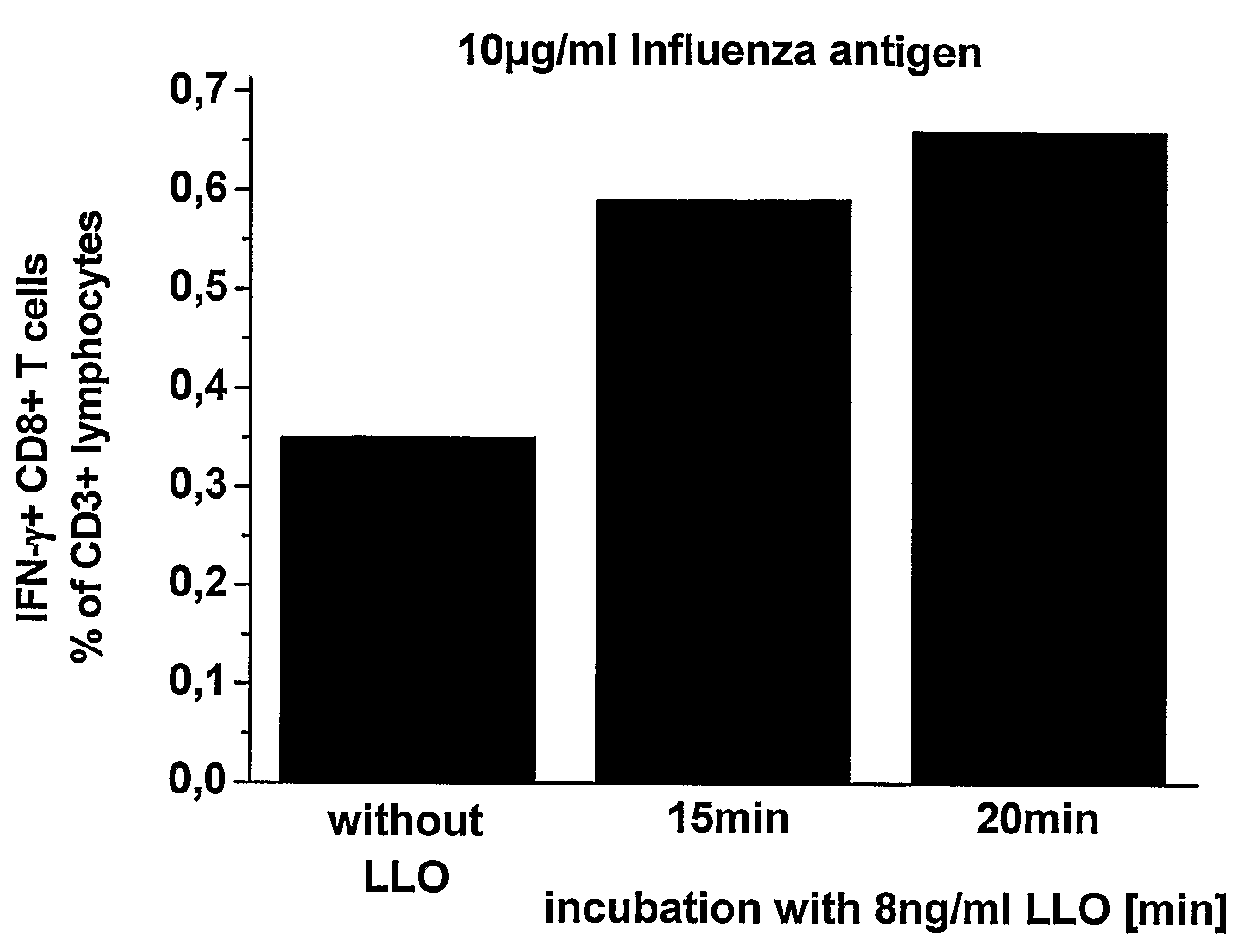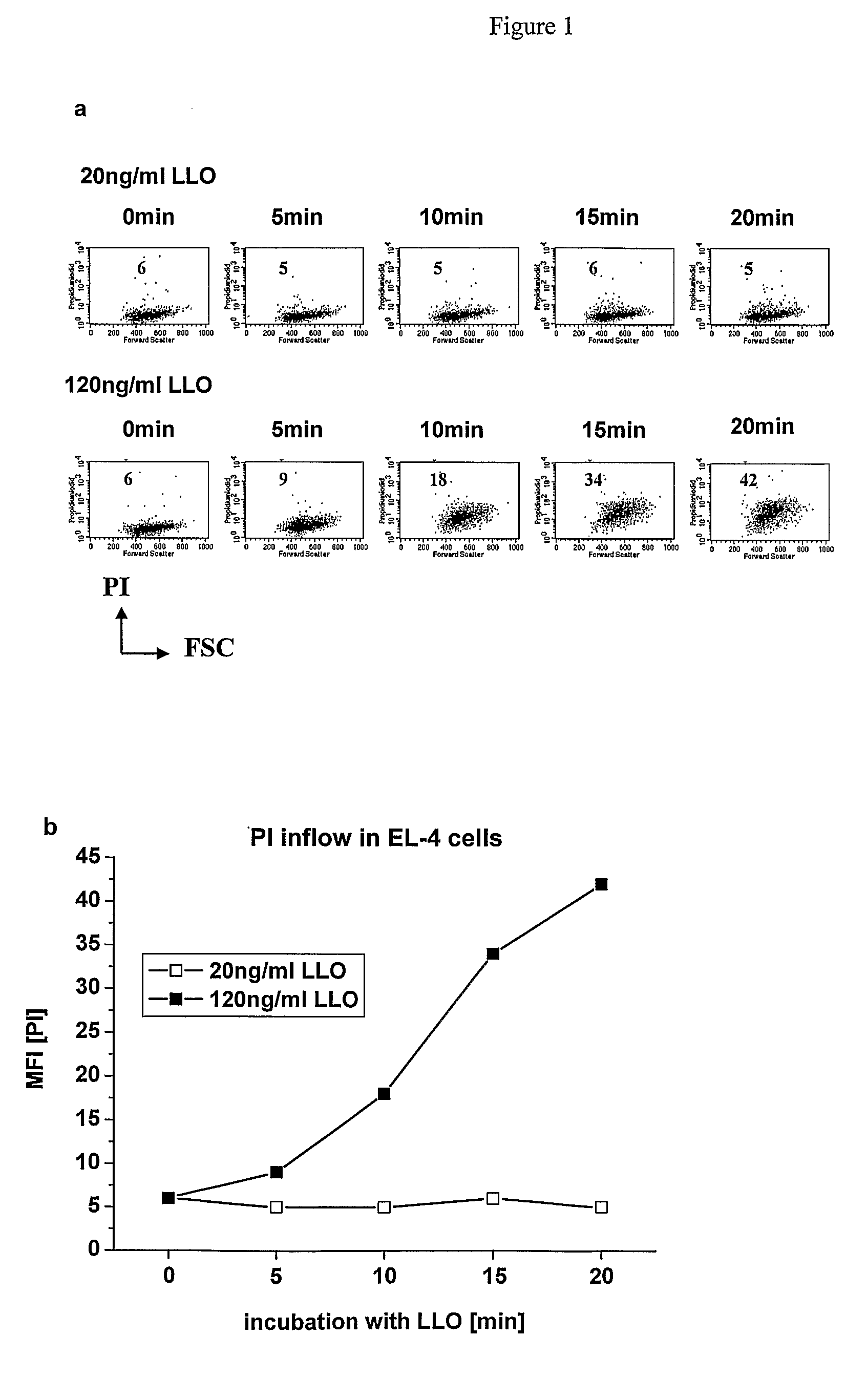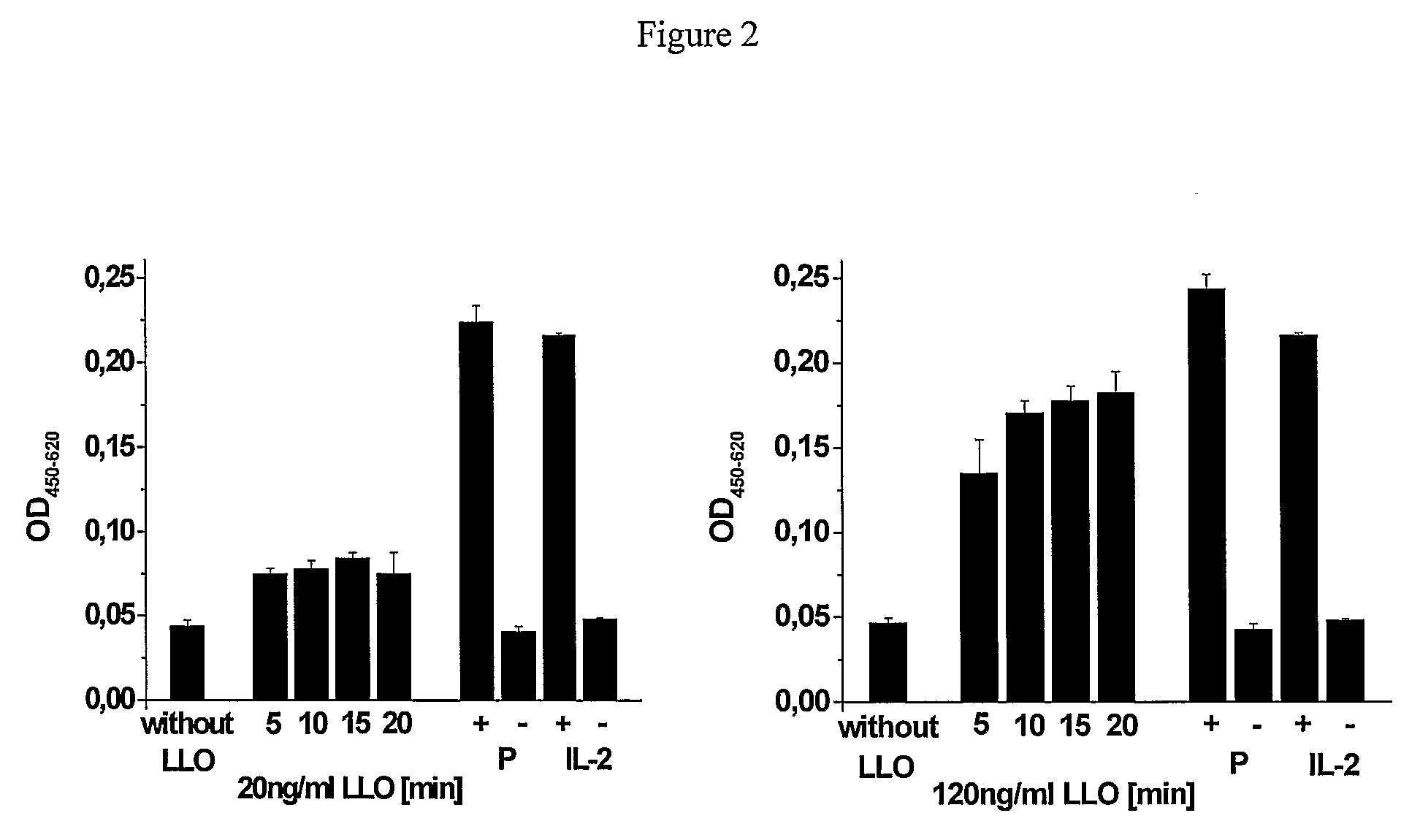Method for the Delivery of Exogenous Antigens into the Mhc Class I Presentation Pathway of Cells
a technology of exogenous antigens and cell pathway, which is applied in the direction of snake antigen ingredients, biochemistry apparatus and processes, blood/immune system cells, etc., can solve the problems of time-consuming, costly, and difficult to perform current methods for targeting the delivery of extracellular antigens for presentation with mhc class i molecules, and achieves no complete success, time-consuming and difficult to perform most protein delivery methods into the cytosol aimed at preserving cell viability
- Summary
- Abstract
- Description
- Claims
- Application Information
AI Technical Summary
Problems solved by technology
Method used
Image
Examples
example 1
Measurement of LLO-Mediated PI Inflow Prior to LLO Incubation for Antigen Delivery
[0109]In this experiment, EL-4 cell line was used as antigen-presenting cells (APCs). Tumor cell line EL-4 (H-2 Kb) was obtained from a C57BL / 6 mouse via bezanthracene induced carcinogenesis (Ghose T., Guclu A., Tai J., Norvell S. T., and MacDonald A. S. 1976. Active immunoprophylaxis and immunotherapy in two mouse lymphoma models. J. Natl. Cancer Inst. 57(2): 303-15; Talmage D. W., Woolnough J. A., Hemmingsen H., Lopez L. and Lafferty K. J. 1977. Activation of cytotoxic T cells by nonstimulating tumor cells and spleen cell factor(s). Proc. Natl. Acad. Sci. USA. 74(10): 4610-4). However, it would be clear to a person skilled in the art that this method can be modified without any difficulty for use with other antigen-presenting cells. The Listeriolysin was produced as described by Darji et al (J. Biotechnol. 1995 Dec. 15; 43(3): 205-12).
A. PI Inflow Measurement in EL-4 Cells During LLO Activity
[0110]In...
example 2
Measurement of LLO Dependent Mean PI Fluorescence Intensity Concomitantly with LLO Incubation for Antigen Delivery into the MHC Class I Presentation Pathway
[0116]EL-4 cells were used as APCs in this experiment. PI inflow was measured concomitantly with LLO incubation for the purpose of antigen delivery. EL-4 cell concentration was adjusted to a cell concentration of 2×106 / ml using RPMI / 25 mM HEPES / 5% FCS at room temperature. 1×106 EL-4 cells were incubated for each batch using various LLO concentrations and incubation times (Table 2).
[0117]After stopping the reactions at the times indicated (by adding 3 ml RPMI / 25 mM HEPES / 5% FCS), the cells were centrifuged and then re-suspended in 1 ml RPMI / 25 mM HEPES / 5% FCS. Following this, triplicates of each batch consisting of 100 μl / well (per 1×105 EL-4 cells) were transferred to a 96-well plate cell and were cultivated for 20 hours using 500 μg / ml ovalbumin (OVA, 45 kDA) and 5×104 B3Z cells / well. MHC class I presentation of OVA (45 kDA) was...
example 3
LLO Incubation in Accordance with Published Data
[0121]Unlike examples 1 and 2, in this example LLO incubation was realized on the basis of published data (Darji A., Chakraborty T., Wehland J., Weiss S. 1995. Listeriolysin generates a route for the presentation of exogenous antigens by major histocompatibility complex class I. Eur. J. Immunol. 25(10):2967-71, und Darji A., Chakraborty T., Wehland J., Weiss S. 1997. TAP-dependent major histocompatibility complex class I presentation of soluble proteins using listeriolysin. Eur. J. Immunol. 27(6):1353-9).
[0122]EL-4 cells were used as APCs and in accordance with the published data were incubated with LLO for purposes of antigen delivery into the MHC class I presentation pathway. The EL-4 cells were adjusted to a cell concentration of 2×106 / ml using RPMI / 25 mM HEPES (37° C. without serum) and were incubated at 37° C. for 15 minutes using 1 μg / ml LLO and 100 μg / ml OVA. Non-LLO batches were tested as controls (table 4).
TABLE 4LLO inRPMIEL-...
PUM
| Property | Measurement | Unit |
|---|---|---|
| Temperature | aaaaa | aaaaa |
| Time | aaaaa | aaaaa |
| Concentration | aaaaa | aaaaa |
Abstract
Description
Claims
Application Information
 Login to View More
Login to View More - R&D Engineer
- R&D Manager
- IP Professional
- Industry Leading Data Capabilities
- Powerful AI technology
- Patent DNA Extraction
Browse by: Latest US Patents, China's latest patents, Technical Efficacy Thesaurus, Application Domain, Technology Topic, Popular Technical Reports.
© 2024 PatSnap. All rights reserved.Legal|Privacy policy|Modern Slavery Act Transparency Statement|Sitemap|About US| Contact US: help@patsnap.com










